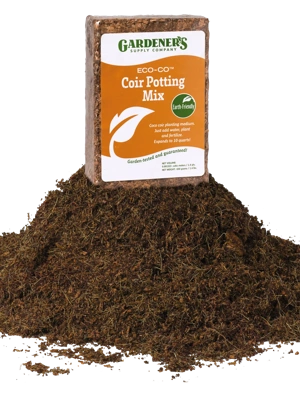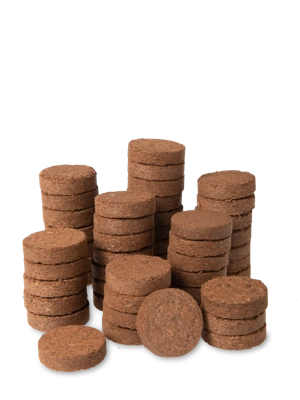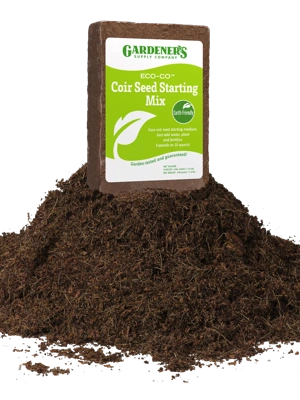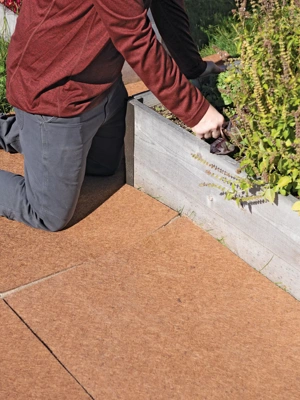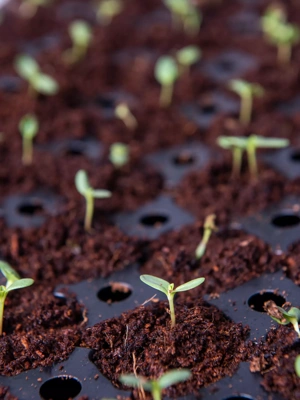Coir: A Better Way to Start Seeds
Seedlings thrive in "soil" made from coconut shells

Seedlings thrive in our new growing medium, Eco-co Coir Seedstarting Mix.
What's coir? Coir, pronounced kwar, is a rising star in horticulture. Also known as "coco coir" because it is made from fibrous coconut husks, coir is an effective, economical and earth-friendly addition or alternative to traditional peat-based blends. We're pleased to present our Eco-co? Coir Seedstarting Mix, the result of years of extensive testing and research.

Eco-co Coir comes in bricks that expand to 10 quarts when rehydrated.
Grow stronger seedlings, harvest bigger and earlier tomato crops and give yourself a green star for using a renewable resource. Simply add coir to your growing repertoire.
Using Coir for Seedstarting
One brick of Eco-co Coir is enough to fill several seed trays.
Coir can be used for all types of seedstarting. We've tested it successfully in all of our seedstarting systems.
It's easy to use. Just rehydrate it with water. One brick of Eco-co Coir Seedstarting Mix expands to about 10 quarts.
Don't Forget to Fertilize
Like most seedstarting mixes, our coir blend is sterile to ensure seedling health. To make sure seedlings get the nutrients they need, fertilize regularly with a liquid fertilizer, such as Plant Health Care for Seedlings.
History
Coir found its way into modern horticulture about 30 years ago. Researchers in the Sri Lankan coconut industry were looking for a way to recycle the coir pith and chips left over from the manufacture of rope, doormats, brushes and other coconut-fiber-based products. Commercial lily and rose growers in Holland soon discovered that coir was a superior substitute for peat that resulted in larger, healthier plants and flowers. Hydroponics growers also embraced coir as an ideal growing medium, and its use continues to increase as word of coir's unique properties spreads.
Structurally Superior
What makes coir so great for growing plants? To see the answer, you have to look at coir through a microscope, which reveals a structure that looks like bundles of drinking straws. These tough, hollow fibers can hold eight to nine times their weight in water, but the arrangement of the bundles allows water to pass easily between them. The space between bundles holds valuable air instead. The result? Coir stores water without becoming soggy, remaining light and fluffy, even when wet.
Those microscopic tubes make coir hygroscopic, which means "able to readily take up and retain moisture." Sphagnum peat moss, on the other hand, is hydrophobic, which means "tending to repel or fail to mix with water." Have you noticed that very dry peat moss forms a water-resistant crust or powder? Well, coir doesn't do that ? it always absorbs water readily.
The tough, outer coconut husk, from which coir is derived, must protect its coconut seed as it floats through the ocean or rests on a hot, sandy beach, resisting predators and waiting to germinate. This decay resistance allows coir to last much longer than peat- or bark-based potting soils, depending on how coarsely the coco coir fibers are milled. That means healthier roots for your plants and less repotting for you.
Disease- and Pest-Resistance
Growing with coir may take a little getting used to, if you're accustomed to watering your pots by looking at or feeling the soil surface. The surface of coir-filled pots looks dry and feels dry to the touch because coir stores water inside its microscopic tubes. This unique property makes coir less hospitable to harmful root-rot fungi, algae and fungus gnats that thrive in moister conditions. Coir's composition makes it attractive to beneficial mycorrhizal fungi, however. Coarse coir fiber, used as landscape mulch, helps to repel snails and slugs, unlike bark mulch.
Coir Quality Matters
To make high-grade horticultural coco coir, such as our Eco-co Coir Seedstarting Mix, raw coir must be processed to remove salts and minerals, and balance the pH for optimal plant growth. Without this treatment, coir contains toxic levels of salt and may have pH levels that prevent plants from accessing nutrients. Lower-grade coir and coir intended for other uses, such as small animal bedding, may be treated differently and may not be suitable for growing plants.
Coir potting mixes contain a blend of particle sizes: pith, fibers and chips. Finely ground coco pith, also called coco peat, holds the most water and the least amount of air. Coco fibers contain the most air, but least water. Coco chips fall in between the two and have the highest air to water ratio. Using different percentages of these three particles, suppliers make custom blends to suit the moisture and air needs of the plants that will grow in it. Our Eco-co Coir Seedstarting Mix, for example, has finely ground coco pith to help speed seed germination and support tender seedlings. The blend of coir we use in our Eco-Co Coir Bricks, which is used to balance the nitrogen in cooking compost, contains all three particle sizes with a higher percentage of fibers and chips to provide plenty of air space, water retention and drainage.
Eco-Co Coir comes compressed into bricks for easy storage, making it more convenient and less bulky than other planting media. A compressed coir brick expands quickly to about 10 quarts of potting mix. Mix it with peat or other potting mixes, or use alone to increase the health of your plants and our planet.
Last updated: 07/13/2023
Print this Article:
Related items
Get the Dirt
Stay up to date on new articles and advice. Please fill out the information below.




